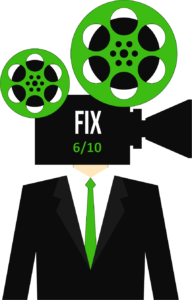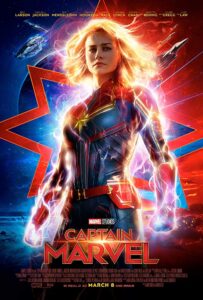This throwback MCU installment fails to land a big punch.


“Captain Marvel” would be a great film had it been made back in the mid-1990s. This MCU outing is set in 1995. It’s a time before the ubiquitous adoption of cell phones, and when the internet was the slow dial-up variety. It was also a time when we didn’t expect much out of our comic book movies.

The fact that the hero this time around is Carol Danvers, an American woman test pilot, who becomes an unstoppable super, isn’t as novel as it might seem. In 1995, Lori Petty was really great in the inventive, if not entirely successful “Tank Girl.” And just the next year, teen boys everywhere, including this one, were jazzed about seeing Pamela Anderson take on the title character in the Dark Horse comic adaptation of “Barb Wire.” Too bad everything about that one was just bad, bad, bad.

But ever since “Iron Man” in 2008 showed us a new way to approach the material, the era of Marvel has produced a steady stream of eminently watchable films, each serving as integral building blocks in what has become one of the most successful cinematic universes in movie history. “Captain Marvel” is sure enough another piece of that growing comic book structure, but it couldn’t be considered a cornerstone. Corny, but without the needed pulp, action-packed without purpose or reason, often shapeless, and a bit morally confused, it’s a failure, but none-the-less necessary viewing.

When Vers (Brie Larson) awakes on a far off planet following a recurring dream, she convinces Yon-Rogg (Jude Law) to join her for some late night good ol’ hand-to-hand combat. We learn that Yon-Rogg is training her to control a mysterious hidden power. Even though she bleeds blue blood like him, Vers is a different sort. Part of the race of the Kree, Yon-Rogg and Vers form a fighting force knows as, well, despite the unique character names, they call their unit the “Starforce.” Locked in a war against the evil shapeshifting Skrulls, Vers and her team get ambushed on another planet eventually leading to her escaping to Earth circa 1995.
Once on Earth, Vers is met by Nick Fury (a made-to-look younger Samuel L. Jackson), who has two functioning eyes, but still sports his cocky, confident demeanor. And his partner is the conscientious Agent Phil Coulson (Clark Gregg, also, looking years younger). Almost instantly, Fury and Vers work together to combat the coming Skrull invasion led by leader Talos (Ben Mendelsohn).

Although the time period is the 1990s, you’d hardly know it. Aside from the juke-box soundtrack and some clothing choices, very little care is taken to make the film seem of that time. If only the movie embraced nostalgia, beyond just brand names. The bland setting could be most any time period, which is a real missed opportunity. Consider what could have been, it was the golden age of the WCW, for example, and despite Fury’s use of a pager, we did have cell phones, even somewhat pocketable (hip-wearing) ones. And when we get a hint of the ‘90s, such moments provide quality chuckles, but there just isn’t enough of them to take us back in time.
And nostalgia shouldn’t be played just for laughs. When Vers arrives on Earth, for example, there should have been more adjustment. Her character is experiencing a recurring sense of deja vu, which is presented in clumsy dreamlike flashbacks that lack much emotional connection. One wonders about her family, who we see in flashbacks and photos, but Vers makes no effort to connect with them. These key parts of her backstory should have been developed, and in doing so, we could’ve gained a greater appreciation for the time and place. And we might have bonded more with Carol Danvers, the human being, who must’ve have been warm and inviting, rather than cold and oh-so-serious “Captain Marvel” alter ego.

Danvers, we casually learn, was always told that because she is a girl, later a woman, that she won’t ever be able to do what a man does. These fleeting scenes don’t sell the theme effectively. And this is what’s wrong with the shape of the screenplay. Because an effort is made to take us on Danvers’ journey through her eyes at a different time in her life, backstory is limited and left ambiguous. She has a form of selective amnesia, but we don’t need to suffer from that as well. Had the movie merely told the story straight, starting with Danvers as a child, we could have believed her inner torment and the concluding act would have been much more impactful.

This perspective choice hobbles the film, confusing the audience and keeping its titular hero always at arms length. I’m convinced that some of the best moments in all of the MCU are the human ones, where we see the vulnerability and understand the psyche of the super. Remember that amazing scene in “Captain America: The First Avenger” when the diminutive Steve Rogers dives on the dummy grenade? There are no lump-in-your throat moments in “Captain Marvel.”
And surprisingly, very little Marvel hip verve can be detected in “Captain Marvel.” The movie moves quickly often abandoning set-up in favor of smashy-bangy fight scenes, the most clever of which have been spoiled in the trailers. And as bodies (Kree, Skrull, and human) get thrown around with reckless abandon, the ones that survive are merely dictated by the plot requirements. For example, there is a scene in which Fury is repeatedly thrown around like a rag doll, but moments later, he gets up with little lasting effects. Whereas, the comparatively stronger Skrull soldiers seem to drop like flies when needed. These inconsistencies extend to a space sequence that could be right out of 1979’s much lampooned “Moonraker.”
And the “Captain Marvel” fight sequences are shot so tightly and the muddy images so murky that everything is almost indecipherable at times. Sadly, the opening battle sequence is dimly lit, and you aren’t sure what you are watching. On top of that, we are introduced in that scene to shape shifters, which only adds to the confusion.
But what is unforgivable is a scene involving a little girl named Monica (played by Akira Akbar), who convinces her mother, Maria (Lashana Lynch), to co-pilot a make-shift craft into space. This excruciating scene takes the position that a single mom should abandon her daughter on a mission from which she may not return. At that point, there’s little indication that her presence is really necessary, and we get no real teary goodbye moment. There was more emotion when Bruce Willis left Liv Tyler to save the world in “Armageddon.” And it points up the throwback nature of the narrative to a time when comic books weren’t meant to be taken seriously at the movies.

But despite the film’s significant short-comings, there are moments that do work. Most of those involve a cat. Fury’s relationship with the soft, furry creature is consistently entertaining, and provides some shocking moments of action and humor. This movie needed more cat.
Sure, “Captain Marvel,” like “Ant-Man,” is meant to show the lighter, more family-friendly side of the MCU, and to that extent, younger viewers should be pleased. But if anything was learned from the stylish success that was “Thor: Ragnarok” or the Oscar nominated narrative heft of “Black Panther,” we expect more out of our superhero movies in 2019.
